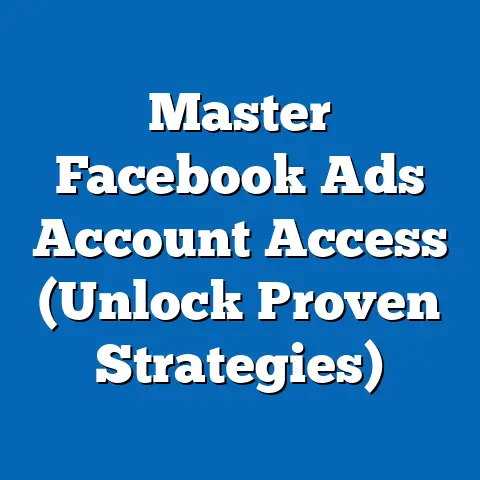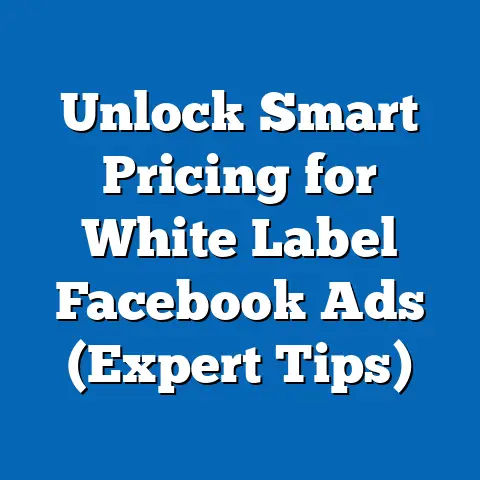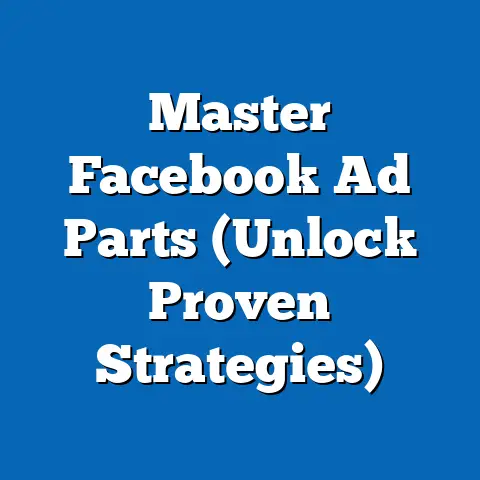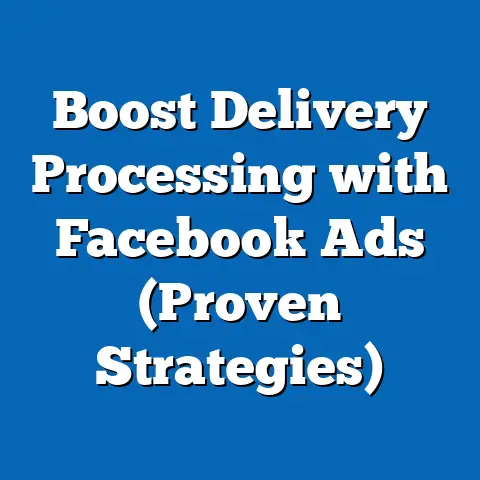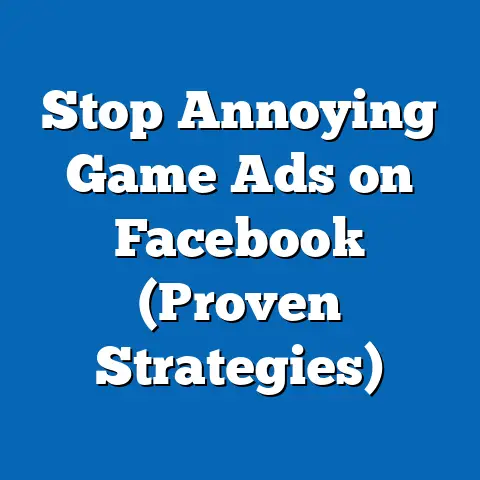Craft First Facebook Ad (Expert Tips Inside)
Would you rather spend hours creating a Facebook ad that flops, or craft one that generates leads and sales effortlessly? I know which one I’d pick! Facebook advertising can feel like navigating a maze at first, but with the right guidance, you can transform it into a powerful tool for your business. In this guide, I’m going to walk you through the essentials of creating your first Facebook ad, sharing expert tips I’ve learned over years of managing successful campaigns. Get ready to unlock the potential of Facebook advertising and start seeing real results!
Understanding the Basics of Facebook Ads
Facebook Ads are essentially paid messages that businesses use to reach potential customers on the Facebook platform. Think of it as a digital billboard, but instead of a static image, you have the power to target specific audiences with tailored messages. In today’s digital landscape, where organic reach is constantly declining, Facebook Ads have become a crucial component of any comprehensive digital marketing strategy. They allow you to bypass the algorithm and get your message directly in front of the people who are most likely to be interested in your products or services.
There’s a whole buffet of Facebook ad types to choose from, each with its own strengths and ideal use cases. Here’s a quick rundown:
- Image Ads: These are your classic, straightforward ads featuring a single image. They’re great for showcasing products, highlighting brand visuals, or conveying a simple message.
- Video Ads: Video ads are incredibly engaging and can capture attention more effectively than static images. Use them to tell a story, demonstrate a product, or share a testimonial.
- Carousel Ads: Carousel ads allow you to showcase multiple images or videos in a single ad unit. They’re perfect for highlighting different features of a product, telling a story in sequence, or showcasing a range of products.
- Slideshow Ads: Similar to video ads, slideshow ads combine a series of images to create a dynamic visual experience. They’re a great option if you don’t have video footage but still want to create an engaging ad.
- Collection Ads: Collection ads are designed for e-commerce businesses and allow users to browse and purchase products directly from the ad. They typically feature a hero image or video with a selection of products displayed below.
- Lead Ads: Lead ads are designed to capture leads directly within the Facebook platform. They feature a form that users can fill out without leaving Facebook, making it easy for them to provide their contact information.
The structure of a Facebook ad is pretty consistent across all ad types. It typically includes three key elements:
- Visual Component: This is the image or video that captures the user’s attention. It should be high-quality, visually appealing, and relevant to your message.
- Ad Copy: This is the text that accompanies the visual. It should be concise, persuasive, and clearly communicate the value proposition of your product or service.
- Call-to-Action (CTA): This is the button or link that encourages users to take a specific action, such as “Learn More,” “Shop Now,” or “Sign Up.”
Takeaway: Facebook Ads are a powerful tool for reaching your target audience and achieving your business goals. Understanding the different ad types and their structure is the first step to creating effective campaigns.
Setting Clear Objectives
Before you even think about crafting your ad, you need to ask yourself: what do I want to achieve with this campaign? Setting clear objectives is absolutely crucial because it dictates everything from your ad creative to your targeting strategy and even your budget. Without a clear goal in mind, you’re essentially throwing money at the wall and hoping something sticks.
Here are some common objectives businesses pursue with Facebook Ads:
- Brand Awareness: This objective is all about getting your brand in front of as many people as possible. The goal is to increase recognition and familiarity with your brand, even if users don’t immediately take any action.
- Lead Generation: If you’re looking to build your email list or collect contact information from potential customers, lead generation is the objective for you. Lead ads are particularly effective for this purpose.
- Website Traffic: Driving traffic to your website is a common objective, especially if you want to showcase your products, share valuable content, or encourage users to explore your site.
- Engagement: This objective focuses on increasing engagement with your content, such as likes, comments, shares, and video views. It’s a great way to build a community around your brand and increase brand loyalty.
- App Installs: If you have a mobile app, this objective is designed to drive downloads and installs.
- Sales Conversions: Ultimately, many businesses use Facebook Ads to drive sales and generate revenue. This objective focuses on getting users to purchase your products or services directly from your ad or landing page.
Each objective requires a different approach. For example, if your goal is brand awareness, you might focus on creating visually appealing ads with broad targeting. On the other hand, if your goal is sales conversions, you’ll want to create highly targeted ads with a clear call-to-action and a compelling offer.
I remember one time, a client came to me wanting to “grow their business” with Facebook Ads. Sounds good, right? But when I pressed them for specifics, they couldn’t articulate a clear objective. Were they looking for more leads? More sales? More website traffic? It was only after a lengthy discussion that we realized their primary goal was to increase brand awareness in a new market. Once we had that clear objective, we were able to tailor their campaign accordingly and achieve much better results.
Takeaway: Always start by defining your objectives. What do you want to achieve with your Facebook ad campaign? Your objective will guide your entire strategy.
Identifying Your Target Audience
Knowing your target audience is like having a secret weapon in your Facebook advertising arsenal. You can have the most beautifully designed ad in the world, but if it’s shown to the wrong people, it’s not going to generate any results. Facebook’s powerful targeting features allow you to reach incredibly specific audiences based on a wide range of factors.
Here are some key demographics, interests, and behaviors you can use to define your target audience:
- Demographics: This includes factors like age, gender, location, education, and job title.
- Interests: This includes things like hobbies, interests, and pages they’ve liked on Facebook.
- Behaviors: This includes things like purchase behavior, device usage, and travel habits.
Facebook also offers two incredibly powerful targeting options:
- Custom Audiences: Custom Audiences allow you to target people who have already interacted with your business in some way. This could include people who have visited your website, watched your videos, or engaged with your Facebook page. You can upload customer lists, use website pixel data, or even create audiences based on engagement with your content.
- Lookalike Audiences: Lookalike Audiences allow you to reach new people who are similar to your existing customers. Facebook analyzes your Custom Audiences and identifies common characteristics, then finds other users who share those traits. This is a great way to expand your reach and find new potential customers.
Creating buyer personas is a fantastic way to get a deeper understanding of your target audience. A buyer persona is a fictional representation of your ideal customer, based on research and data about your existing customers. It should include details like their age, gender, occupation, interests, pain points, and goals.
I once worked with a small business that was struggling to get results from their Facebook Ads. They were targeting a broad audience and their ads weren’t resonating with anyone. After creating detailed buyer personas, we realized that their ideal customer was a very specific demographic with unique interests and pain points. By tailoring their ads to speak directly to that audience, we saw a dramatic increase in engagement and conversions.
Takeaway: Take the time to thoroughly research and define your target audience. Use Facebook’s targeting features to reach the right people with the right message. Creating buyer personas can help you better understand and connect with your audience.
Crafting Compelling Ad Copy
Your ad copy is your chance to speak directly to your target audience and convince them to take action. It’s the bridge between your visual and your call-to-action. Writing compelling ad copy is an art, but there are a few key principles that can help you create persuasive messages.
- Strong Headline: Your headline is the first thing people will see, so it needs to grab their attention and make them want to learn more. Use strong verbs, numbers, and keywords to make your headline stand out.
- Relatable Message: Your ad copy should speak directly to the needs and desires of your target audience. Use language that resonates with them and addresses their pain points.
- Urgency: Creating a sense of urgency can encourage people to take action immediately. Use phrases like “Limited Time Offer” or “Don’t Miss Out” to create a sense of scarcity.
- Benefits, Not Features: Focus on the benefits of your product or service, rather than just the features. Explain how it will solve their problems or improve their lives.
Storytelling is a powerful technique for making your ads more engaging. People are naturally drawn to stories, and they’re more likely to remember and connect with an ad that tells a compelling narrative.
I’ve found that the best ad copy is concise and focused on the audience’s needs and desires. Avoid using jargon or overly technical language. Keep your message simple and easy to understand.
Takeaway: Write persuasive ad copy that speaks directly to your target audience. Use a strong headline, relatable message, and urgency to encourage them to take action. Storytelling can make your ads more engaging and memorable.
Designing Eye-Catching Visuals
Visuals are the first thing people notice when they see your Facebook ad. In a world of constant scrolling, you have just a few seconds to capture their attention. That’s why it’s crucial to use high-quality, visually appealing images and videos that stand out from the crowd.
Here are some guidelines for creating effective visuals:
- High Resolution: Use images and videos that are high resolution and clear. Avoid blurry or pixelated visuals.
- Branding: Incorporate your brand colors, logo, and fonts into your visuals. This will help people recognize your brand and associate it with your message.
- Color Psychology: Consider the emotional impact of different colors. Use colors that are consistent with your brand and that evoke the desired feelings.
- Relevance: Your visuals should be relevant to your message and your target audience. Use images and videos that resonate with their interests and needs.
Consistency in visual branding is key. Use the same colors, fonts, and imagery across all of your ads to create a cohesive brand identity.
I’ve seen firsthand how powerful visuals can be. I once worked with a client who had a great product but their ads were underperforming. Their visuals were low-quality and didn’t effectively showcase the product. After investing in professional photography and videography, their ads saw a dramatic increase in engagement and conversions.
Takeaway: Use high-quality, visually appealing images and videos that capture attention quickly. Incorporate your brand colors, logo, and fonts to create a cohesive brand identity.
Incorporating a Strong Call-to-Action (CTA)
Your call-to-action (CTA) is the final piece of the puzzle. It’s the instruction that tells people what you want them to do next. A strong CTA can be the difference between a passive viewer and a valuable customer.
Why is a CTA so crucial? It provides clear direction. Without a CTA, people may be interested in your ad but they won’t know what to do next. It drives action. A well-crafted CTA can motivate people to click on your ad, visit your website, or make a purchase. It measures results. CTAs allow you to track the effectiveness of your ads and see how many people are taking the desired action.
Here are some examples of effective CTAs tailored to different campaign objectives:
- Learn More: Use this CTA if you want people to visit your website and learn more about your product or service.
- Shop Now: Use this CTA if you want people to make a purchase directly from your ad.
- Sign Up: Use this CTA if you want people to subscribe to your email list or create an account.
- Download: Use this CTA if you want people to download a free resource, such as an ebook or whitepaper.
- Contact Us: Use this CTA if you want people to reach out to your business with questions or inquiries.
Placement is key. Make sure your CTA is visible and easy to click on. Place it prominently within your ad, either as a button or a text link.
I always advise clients to test different CTAs to see which ones perform best. You might be surprised at how much of a difference a simple change in wording can make.
Takeaway: Always include a clear and compelling call-to-action in your Facebook ads. Choose a CTA that is tailored to your campaign objective and make sure it’s visible and easy to click on.
Setting a Budget and Scheduling
Setting a budget and scheduling your ads are two crucial aspects of Facebook advertising that can significantly impact your campaign’s success. It’s not just about throwing money at the platform; it’s about making informed decisions that maximize your ROI.
When it comes to setting a budget, you have two main options:
- Daily Budget: This is the average amount you’re willing to spend per day on your ads. Facebook will try to spend this amount each day, but it may fluctuate slightly depending on the performance of your ads.
- Lifetime Budget: This is the total amount you’re willing to spend on your ads over the entire duration of the campaign. Facebook will try to distribute your budget evenly over the specified time period.
Facebook offers several bidding strategies, each designed to optimize your ads for different goals:
- Cost Per Click (CPC): You pay each time someone clicks on your ad. This is a good option if you’re focused on driving traffic to your website.
- Cost Per Impression (CPM): You pay for every 1,000 impressions your ad receives. This is a good option if you’re focused on brand awareness.
- Cost Per Conversion (CPA): You pay each time someone takes a desired action, such as making a purchase or signing up for a newsletter. This is a good option if you’re focused on driving conversions.
Scheduling your ads is just as important as setting a budget. You want to make sure your ads are running when your target audience is most active on Facebook.
I’ve learned that testing different schedules is essential. What works for one audience may not work for another.
Takeaway: Set a budget that aligns with your business goals and choose a bidding strategy that optimizes for your desired outcome. Schedule your ads to run when your target audience is most active on Facebook.
Monitoring and Optimizing Your Ad Performance
Once your ads are up and running, your job isn’t over. In fact, it’s just beginning. Monitoring and optimizing your ad performance is crucial for maximizing your ROI and achieving your campaign goals.
Facebook Ads Manager is your control center for tracking and analyzing your ad performance. It provides a wealth of data about your ads, including:
- Impressions: The number of times your ad has been shown to users.
- Reach: The number of unique users who have seen your ad.
- Clicks: The number of times people have clicked on your ad.
- Click-Through Rate (CTR): The percentage of impressions that resulted in a click.
- Cost Per Click (CPC): The average cost you paid for each click.
- Conversions: The number of people who took a desired action after seeing your ad, such as making a purchase or signing up for a newsletter.
- Conversion Rate: The percentage of clicks that resulted in a conversion.
- Cost Per Conversion (CPA): The average cost you paid for each conversion.
Interpreting these metrics is key to assessing your ad’s effectiveness. A high CTR indicates that your ad is engaging and relevant to your audience. A high conversion rate indicates that your landing page is effective at converting visitors into customers. A high CPA indicates that you’re paying too much for each conversion and need to optimize your ads or landing page.
A/B testing is a powerful technique for optimizing your ads. It involves creating two versions of your ad with slight variations and then testing them against each other to see which one performs better.
I’ve found that even small changes can have a big impact on ad performance. Don’t be afraid to experiment and try new things.
Takeaway: Monitor your ad performance regularly and use Facebook Ads Manager to track key metrics. Use A/B testing to optimize your ads and improve your ROI.
Common Pitfalls to Avoid
Creating your first Facebook ad can be exciting, but it’s also easy to make mistakes, especially if you’re new to the platform. Here are some common pitfalls to avoid:
- Vague Targeting: Targeting too broad of an audience can result in wasted ad spend and low engagement. Be specific about your target audience and use Facebook’s targeting features to reach the right people.
- Poor Visuals: Using low-quality or irrelevant visuals can turn people off and prevent them from clicking on your ad. Invest in high-quality visuals that capture attention and showcase your product or service effectively.
- Unclear CTAs: If your CTA is unclear or confusing, people won’t know what you want them to do. Use clear and concise CTAs that tell people exactly what action you want them to take.
- Ignoring Mobile Users: A significant portion of Facebook users access the platform on their mobile devices. Make sure your ads are optimized for mobile viewing and that your landing pages are mobile-friendly.
- Neglecting A/B Testing: A/B testing is essential for optimizing your ads and improving your ROI. Don’t neglect this crucial step.
- Not Monitoring Performance: Once your ads are running, it’s important to monitor their performance regularly and make adjustments as needed. Ignoring your ad performance can result in wasted ad spend and missed opportunities.
I’ve seen so many beginners fall into these traps. By avoiding these common pitfalls, you can increase your chances of success and get the most out of your Facebook advertising campaigns.
Takeaway: Be aware of these common pitfalls and take steps to avoid them. By doing so, you can increase your chances of success and get the most out of your Facebook advertising campaigns.
Conclusion
Crafting your first Facebook ad doesn’t have to be daunting. By understanding the basics, setting clear objectives, targeting the right audience, writing compelling copy, designing eye-catching visuals, incorporating a strong call-to-action, setting a budget, scheduling your ads, monitoring performance, and avoiding common pitfalls, you can create effective campaigns that drive results.
Remember, practice makes perfect. Don’t be afraid to experiment and try new things. The more you work with Facebook Ads, the better you’ll become at creating campaigns that resonate with your target audience and achieve your business goals.
Now, take your newfound knowledge and confidently create your first Facebook ad. You’ve got this!

